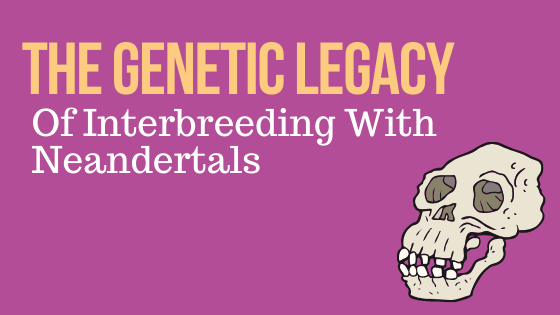Publishing a draft of the Neandertal genome (1) opened up whole new avenues to understanding the ancestry of modern humans. No longer constrained to comparing the morphology of fossilized remains, scientists can now delve into the genetic differences between anatomically modern humans and our close relative Homo neanderthalensis. From these genetic studies, we are learning some amazing things about the evolution of Homo sapiens.
Written by: Terri Sundquist, Promega
Due to technological advances, genome sequencing has become rather commonplace, with almost 20,000 genomes sequenced to date according to the Genomes Online Database. However, publication of the draft Neandertal genome by Green et al. in 2010 represented a huge challenge: The starting material for DNA extraction was not a pristine laboratory specimen but rather 21 Neandertal bones deposited in Vindija Cave in Croatia approximately 40,000 years ago. The average DNA fragment length was less than 200 base pairs, data interpretation was complicated by chemical modification of the DNA (e.g., deamination), any contamination by modern human DNA sequences had to be eliminated from the results, and the desired target DNA represented less than 5% of the total DNA isolated, with 95–99% of the DNA originating from nonprimate sources—presumably microbes that colonized the body after death. Perhaps it’s no wonder that the international team required to complete this task consisted of 56 researchers from 20 different institutes.
The team’s hard work paid off. Analysis of the Neandertal genome revealed new information about both the extinct H. neanderthalensis and modern H. sapiens, including interbreeding between the two hominids before Neandertals disappeared from the fossil record about 30,000 years ago. This interbreeding took place after modern humans migrated out of Africa at least 200,000 years ago and came into contact with Neandertals. As modern humans dispersed across Eurasia, Neandertal genes came to constitute as much as 4% of their genomes, and this flow of genetic information was almost exclusively from Homo neanderthalensis to the ancestors of modern nonAfrican humans.
Through genetic analysis, Green et al. were able to compile a partial list of genes that seem to have evolved since Neandertals and modern humans diverged from their common ancestor. Importantly, several of these genes—DYRK1A, NRG3, CADPS2 and AUTS2—are related to cognition and brain development, and mutations within these genes are associated with Down Syndrome, schizophrenia and autism, respectively. Another important modern human-specific gene is RUNX2, which affects morphology of the cranium and upper body and seems to explain some of the differences in skeletal morphology between modern humans and Neandertals. Their work also generated a list of genes that modern humans share with Neandertals, including MC1R, which influences skin and hair pigmentation, and FOX2P, a gene involved in speech and language, as well as genes involved in the ABO blood group system and genes that encode taste receptors.
The introduction of certain Neandertal genes into the genome of modern nonAfricans through interbreeding may have conferred an evolutionary advantage in their new environment. For example, Neandertal genes that influence keratin filament formation, and thus skin and hair morphology, are enriched in people of European and East-Asian ancestries and may have helped modern humans adapt to conditions outside of Africa (2). Neandertal genes that encode immune system components may have made modern humans more resistant to new pathogens encountered during their transcontinental trek (3). However, some of the shared genes have medical implications and have been linked to lupus, biliary cirrhosis, Crohn’s disease, type-2 diabetes and smoking behavior. For example, a variant of SLC16A11, a poorly characterized members of the monocarboxylic acid transporter family, is strongly linked to type 2 diabetes (4). The benefits of these Neandertal genes for our early modern ancestors must have outweighed any detrimental effects.
While interbreeding between Neandertals and modern humans had advantages, there were also evolutionary costs. Negative selection has resulted in large “desert” regions depleted of Neandertal DNA in the modern human genome (2). The largest desert, which exists on the X chromosome, contains a number of genes that affect male fertility, leading researchers to speculate that certain Neandertal alleles reduced fertility of male hybrids and were removed from the population relatively quickly. Similar desert regions have been identified at 8q and 17p (5). Thus, incorporation of Neandertal DNA into the modern nonAfrican human genome was a genetic balancing act: Pass advantageous genes down to subsequent generations, and quickly weed out any detrimental genes.
Interestingly, genetic analyses also suggest that many modern humans carry other early hominid DNA in their cells. Prüfer et al. have sequenced DNA from a Neandertal bone discovered in the Denisova Cave in the Altai Mountains in east-central Asia (6) and compared this genome sequence to that of the Denisovans, a recently discovered close relative or subspecies of Homo neanderthalensis. Perhaps not surprisingly, the Denisovan genome sequence (7) showed signs of Neandertal gene influx, with at least 0.5% of the Denisovan genome having Neandertal origins. By comparing the Denisovan genome sequence to the genome sequences of more than 1,000 modern humans, Prüfer et al. also detected Denisovan genes in native populations of modern humans in Australia, Melanesia and the Philippines (3–6% of the total genome) and mainland Asia and the Americas (~0.2%). Finally, they also detected gene flow into the Denisovan genome from an unknown hominid that shared a common ancestor with modern humans, Neandertals and Denisovans but made an evolutionary split from these other hominids between 1.1 and 4 million years ago. Thus, the data support the hypothesis that there was interbreeding between many species of early hominids during the Late Pleistocene. However, additional research is needed to better understand these genetic exchanges.
In only four years, what started out as an immense challenge—sequencing the Neandertal genome from ~40,000-year-old bones discovered in Vindija Cave—has become the basis for new methods to understand human evolution. The initial Neandertal genome sequence paved the way for sequencing of other hominid genomes and even a fossil-free paradigm of genome sequencing, by which remnants of ancient hominid DNA can be identified in modern humans and used to partially reconstruct genome sequences in the absence of fossilized remains (5). I am excited to think what scientists can learn in the next four years.
References
- Green, R.E. et al. (2010) A draft of the Neandertal genome. Science 328, 710–22. PMID 20448178
- Sankararaman, S. et al. (2014) The genomic landscape of Neanderthal ancestry in present-day humans. Nature 507, 354–7. PMID 24476815
- Mendez, F.L., Watkins, J.C. and Hammer, M.F. (2013) Neandertal origin of genetic variation at the cluster of OAS immunity genes. Mol. Biol. Evol. 30 798–801. PMID 23315957
- The SIGMA Type 2 Diabetes Consortium (2013) Sequence variants in SLC16A11 are a common risk factor for type 2 diabetes in Mexico. Nature DOI: 10.1038/nature12828.
- Vernot, B. and Akey, J.M (2014) Resurrecting surviving Neandertal lineages from modern human genomes. Science 343, 1017–21. PMID 24476670
- Prüfer, K. et al. (2014) The complete genome sequence of a Neanderthal from the Altai Mountains. Nature 505, 43–9. PMID 24352235
- Meyer, M. et al. (2012) A high-coverage genome sequence from an archaic Denisovan individual. Science 338, 222–6. PMID 22936568
WOULD YOU LIKE TO SEE MORE ARTICLES LIKE THIS? SUBSCRIBE TO THE ISHI BLOG BELOW!
SUBSCRIBE NOW!


